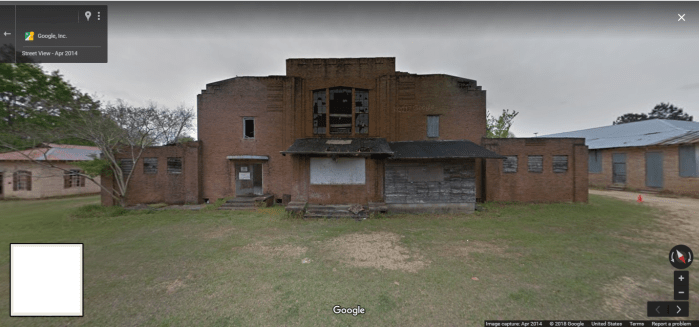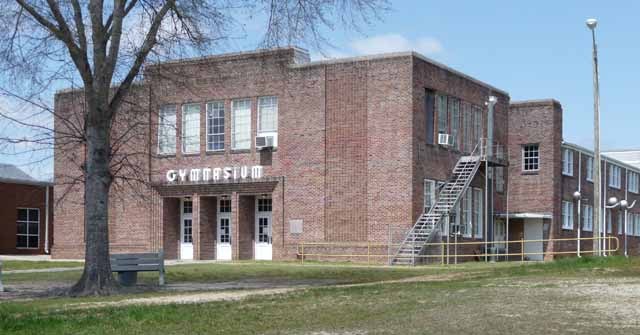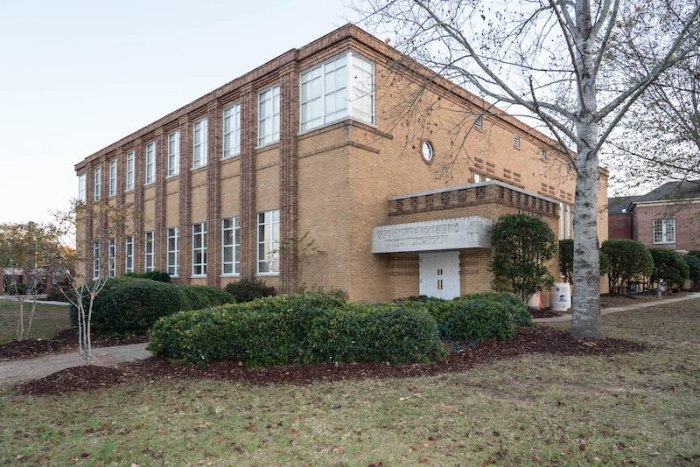
Thanks to W. White’s meticulous work, many of us were fortunate to get a glimpse of the Art Deco gymnasium-auditorium in the rural community of Carson, featured recently in the Name This Place XIII: Google Street View Edition, only to subsequently learn of its recent March 2019 demise by fire. W. White’s comment about the rarity, and the uniqueness, of the Art Deco styled gymnasium in a rural area indicated to me that it needed a little further exploration. We had already lost a unique building to neglect before its further total destruction by fire.
We already know it was a project funded by the Federal Emergency Administration of Public Works Projects Division (PWA). The Jefferson Davis county board of supervisors directed a bond election in 1933 to erect a gymnasium/auditorium for the Carson consolidated school. The bond was passed, but the Mississippi courts found the issue invalid due to procedural errors, and subsequently ruled the board could not proceed. The board rectified those errors eventually, however, the first submission to PWA was rejected with recommendation for disapproval. The Carson school was among 13 projects disapproved because
…the man-year cost was too high. (Clarion-Ledger, Sep. 12, 1935, p. 16)
The application was revised to lower wage costs and other possible expenditures and resubmitted. The board addressed the bond issues and moved further toward the ability to construct the gymnasium/auditorium for Carson school. The request for a two story brick, four classroom, auditorium and gymnasium combined, for a total of $27,272 was approved. The Art Deco structure was completed in summer of 1936 and opened for the school year Sep. 7, 1936. The opening program was held in the newly completed building.
With its additional school rooms as well as its splendid gymnasium and auditorium, it will add much to the efficiency with which the school program can be carried on this year and the years to come. (Carson School slates opening, 1936, p. 9)
Were there other Art Deco schools in Mississippi, particularly in rural areas? Apparently, W. White called it half right (though I am willing to be corrected). I located two references to Art Deco gymnasiums in Mississippi–on Preservation in Mississippi, of course.

Runnelstown, Perry County
On the way, I check in on one of my favorite Art Deco gymnasiums in the state at the rural crossroads of Runnelstown…(E. L. Malvaney, 2010, To Leakesville and Back)
The Runnelstown gymnasium was constructed 1940 according to MDAH. It may have been a New Deal project (no agency named) as the Clarion-Ledger reported January 25, 1940 that Senator Bilbo had wired the newspaper that the president had authorized the construction of the gymnasium, classroom and grounds improvement, but the federal allotment was only $3,061. The gymnasium was reported completed September 4, 1940 (Hattiesburg American).

Madison-Ridgeland
As was Carson’s gymnasium, the Art Deco gymnasium at Madison-Ridgeland school was completed in 1936. Although not a rural gymnasium as were the other two, this building was also described as
…a rare example of the Art Deco style in Mississippi, particularly as it was applied to schools. (Susan M. Enzweiler, 1986, Historic Sites Survey, Mississippi Department of Archives and History)
A rather diligent search did not turn up any other Mississippi examples that were specifically identified as Art Deco, although as always, we can count on MissPres readers to let us know of any in your neck of the woods, hills, low country, delta…A few details are indicated in 3 school gymnasiums, one of which is identified in the MDAH data base as Art Deco, Art Moderne. Others also carry Art Moderne influences as well. All images below are from the 1513 School Photograph Scrapbooks series, Mississippi Department of Archives and History.
Just for fun, I include a couple of photographs of our neighbor states, Louisiana and Tennessee. While the Tennessee school was a planned excursion, I spotted the Ruston Art Deco tower while refueling on a trip home from Texas, and encountered Art Deco heaven.
Categories: Architectural Research, Cool Old Places, Demolition/Abandonment, Historic Preservation, New Deal







I can’t get enough Art Deco and this certainly gave me a fix. I came across one example of an Art Deco gymnasium in Navasota TX. I checked on it a few weeks ago and was pleased to find it little changed from previous visits. I can only imagine the thrill of the first game in it and the pride of the community – a new gymnasium in the midst of the depression! https://livingnewdeal.org/projects/old-rock-gym-navasota-tx/
LikeLiked by 3 people
The Navasota Gym is a find! Thanks for the link!
LikeLike
Wow, gorgeous!
LikeLike
Yes, I probably should not have referred to Carson as the “only” art deco gymnasium, especially since I was aware of Runnelstown (I ignored Madison-Ridgeland because it is not rural, though the area was more rural when it was built). Oh well.
There are probably another one or two additional ones that, like Carson, are hiding in very small communities in out-of-the-way places like the Delta or Piney Woods. Only a whole bunch of Street Viewing, either on Google or the old fashioned way via internal-combustion engine-propelled vehicle, will give a definitive answer.
But, there are certainly many, many more art moderne gyms than art deco ones in both urban and rural areas.
LikeLiked by 2 people
I do not think you said it was the only one; you said there were no other rural that you were aware of, and apparently you were right for the most part. It was not a criticism–I just enjoy ferreting out details like this–it is my self-care. I find that buildings and archives seldom smack-talk me.
LikeLike
It’s interesting that the Carson and Runnelstown gyms both appear to have similar or maybe identical interior plans, with four classrooms in the two-story section in front of the big gymnasium space. Most rural gyms of the period were standardized clapboard or asbestos-shingled buildings with gable roofs and shed roof on each long side over the bleachers. These two brick gyms are much more substantial and ambitious.
LikeLiked by 1 person
I was actually surprised as I looked through the 1513 series at the few exceptions to what you describe above. I grew up in definitely rural areas in Texas, but our gymnasiums were rock, brick, or stucco-covered brick. Maybe because rock was easier to come by than wood in an area that had few trees unless they were mesquite.
LikeLike
And nary any mention of an architect for either. There had to be one with buildings like those.
Look at Carson Gym. There is no standardized plan for a facade with angled pilasters, pointed tripartite central window, angled corner parapets, or the unusual “quoins” and “dentils” (closest terms I could think of to describe those features). So someone had to design Carson Gym, unless it is a case of a Depression-era contractor and/or brick mason just going nuts of his own volition, because all those features took time and materials, and time and materials are money.
Also, the post “To Leakesville and Back” states that there is no plaque on the exterior of the Runnelstown Gym. What is that to the right of the front doors, then? It is gray, square, and prominently placed on the front facade: all plaque-like traits.
LikeLiked by 1 person
Great post. RE-posted on twitter @trefology
LikeLike